
Hetsu-miya, Munakata Taisha
Center of Faith in the Three Female Deities of Munakata,
Passed Down Since Ancient Times
Hetsu-miya, which is located near the Tsurikawa River in Tashima, Munakata City, is one of the three shrines that comprise Munakata Taisha. It enshrines Ichikishimahime-no-Kami, one of the Three Female Deities of Munakata.
The Shimotakamiya ritual site is situated on a hill over-looking a former sea inlet near the Tsurikawa River. The existence of this site later led to the construction of the shrine buildings at the base of the hill.
Hetsu-miya has become the central venue for Munakata Taisha's rituals dedicated to the Three Female Deities of Munakata, which are deeply connected to the sea abd river.
Visitors passing through the torii gate and proceeding along the path will find the Main Hall beyond the Shinmon gate.
On this site, shrine buildings had been constructed by the twelfth century, but were repeatedly destroyed in battles and fires. After the most recent destruction caused by a fire in 1557, the present Main Hall was built in 1578 by Munakata Ujisada, who was a daiguji, the highest ranking priest of the shrine. Since he had no children, the family of the Munakata daiguji died out.
The present Worship Hall was built in 1590 by Kobayakawa Takakage, who was then the lord of this region. Subsequently, the Kuroda family began to govern the Fukuoka Domain and successive lords of the family funded the repair and maintenance of the shrine buildings.
In this way, faith in the Three Goddesses has been passed on through many generations to the present day. Both the Main Hall and Worship Hall have been designated as Important Cultural Properties by the Japanese government.
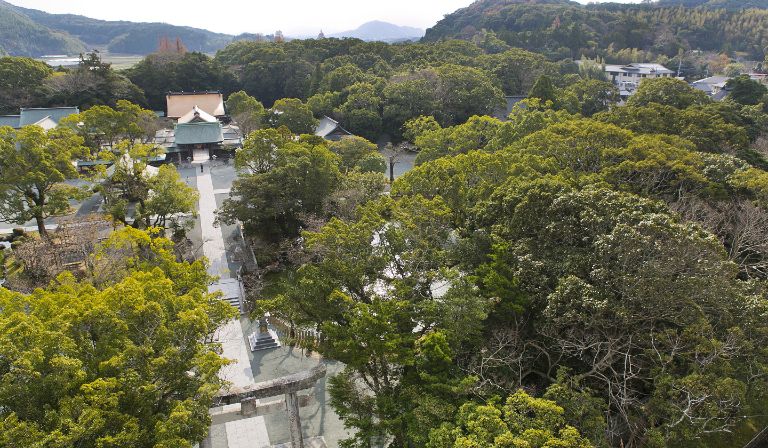
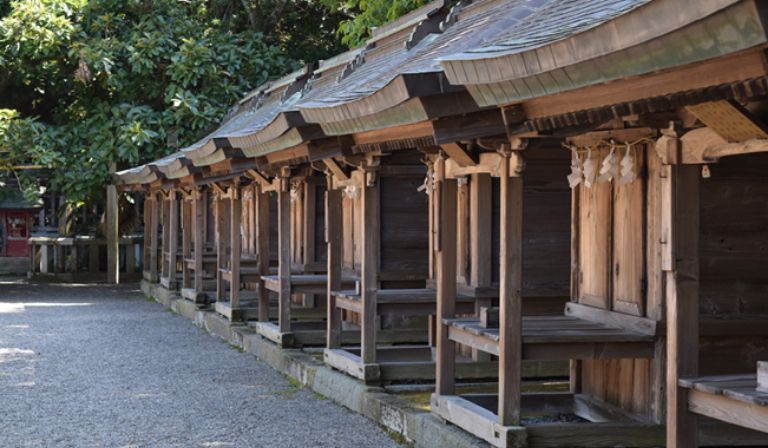
Adjacent to the main hal and worship hall are several small subordinate shrines. These were relocated to the present site from other sites in the Munakata region in 1675 by Kuroda Mitsuyuki, the third lord of the Fukuoka Domain.
Some shrine buildings standing today were actually built that year.
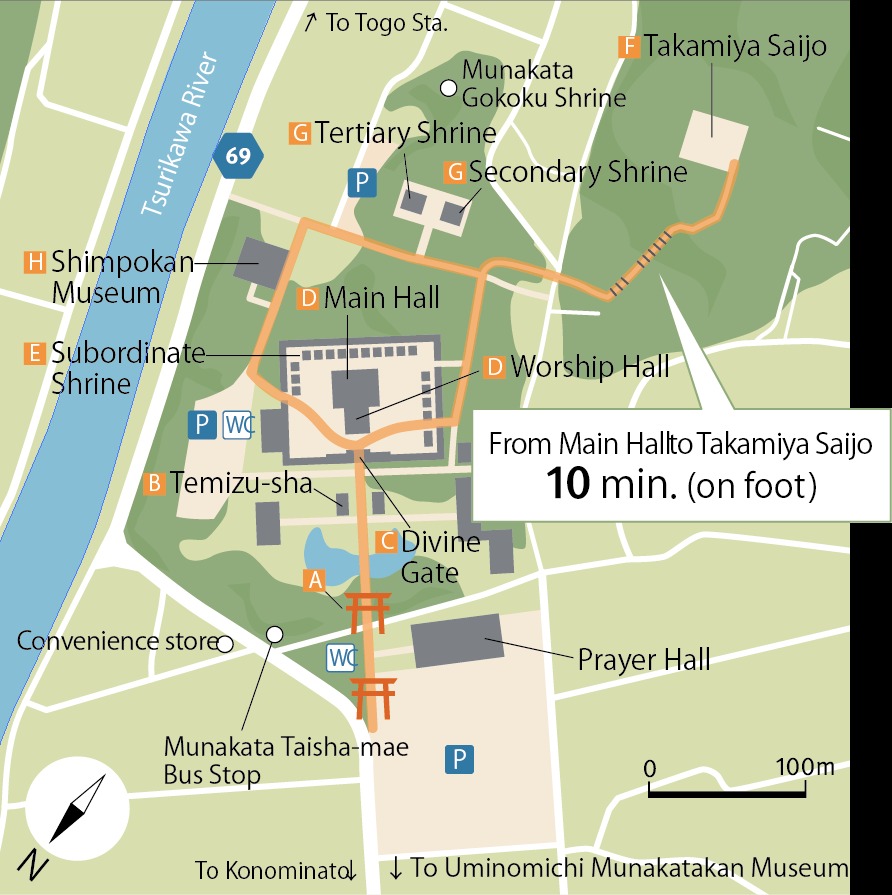
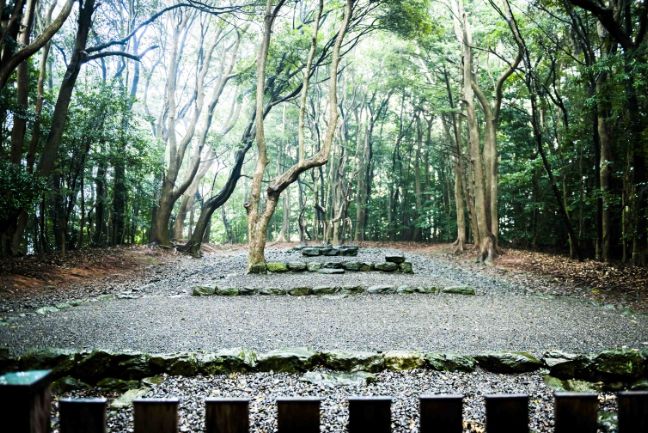
Following the path beside the shrine buildings, visitors will find steps on behind the shrine that lead up Mt. Munakata. The steps lead to Takamiya Saijo (Ceremonial Site), where ancient rituals were performed. Takamiya Saijo is very important since the rituals currently observed at Hetsu-miya originated there. To the northwest of the ceremonial site, visitors can view the marine route linking Hetsu-miya with Okinoshima via the Tsurikawa River, Oshima, and finally across the Genkai Sea.
Visitors who descend the hill from Takamiya Saijo will find two shrine buildings. During medieval times, Hetsu-miya comprised three important shrines: the primary, secondary, and tertiary shrines, respectively called Tei-ichi-gu, Tei-ni-gu, and Tei-san-gu. The present Main Hall and Worship Hall of Hetsu-miya originally comprised the primary shrine.
The two shrine buildings standing behind the two halls are the secondary and tertiary shrines, which are respectively dedicated to Tagorihime-no-Kami of Okitsu-miya, and Tagitsuhime-no-Kami of Nakatsu-miya. The present structures of the secondary and tertiary shrines were the subordinate shrines of Ise Jingu Shrine, gifted in 1973, when the subordinate shrines in Ise rebuilt their structures on the 60th Shikinen Sengu (regular construction of new shrine buildings).
Since the Main Hall of Hetsu-miya enshrines Ichikishimahime-no-Kami, visiting all three shrines allows visitors to worship the three female deities of Munakata.
Access
Munakata Taisha-mae
Hetsu-miya, Munakata Taisha
Munakata Taisha-mae
Uminomichi Munakatakan Museum
Hetsu-miya and the sea inlet
The Tsurikawa River flows through Munakata City, and the Katsuura Lagoon that opens out in Fukutsu City was once a sea inlet.
Various tributaries flowing down from the mountains join together to form the Tsurikawa River, which then flows into the Genkai Sea. It has been an important water source for the Munakata region since ancient times. People have always lived near the river and it has been a central part of their lives.
The Tsurikawa River flowing into the sea is described in the Nihonshoki, written with the characters for "seaside" that actually indicated "Hetsu-miya."
During the medieval period, at Munakata Taisha there were many Shinto rituals that focused on the sea and river. In the Funakurabe (Sea Battle) Ritual in the Hojo-e ceremony,, the Munakata fishing villages of Kanezaki, Konominato, Katsuurahama, and Tsuyazaki make offerings to a sacred boat said to be carrying the deities, which are then placed on a portable shrine and raced in a boat race on the Tsurikawa River.
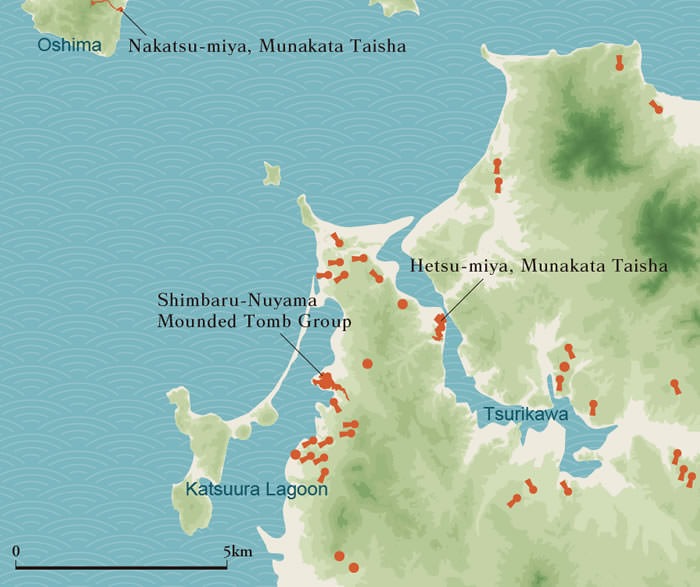
The sacred Munakata district
In the mythology of the Kojiki and Nihonshoki, the Three Female Deities of Munakata are said to govern the northern sea route, or in other words, the passage leading from the Munakata region to the Korean peninsula.
The Munakata region (Munakata City and Fukutsu City) was once called the Munakata district (gun), and historically it was considered as a single geographical entity.
In the ancient ritsuryo legal system, some local districts where especially important shrines for the state were located were called "sacred districts" (shingun). Munakata was designated as one of these eight sacred districts.
In the Munakata region, each community had its tutelary deity, hence the existence of many subordinate shrines affiliated with Munakata Taisha. During the medieval period, there were 75 subordinate shrines within the Munakata district. In the Munakata region, many shrine parishioners were affiliated with both Munakata Taisha and their village shrines (tutelary deities). They kept the shrine precincts clean and participated in rituals. Within daily life they continue their work to preserve the shrines with great attentiveness and care.
Munakata Taisha and its parishioners
Ujiko are shrine parishioners, the worshippers under the protection of a local tutelary deity. Deep faith in the deity bonds the members of these groups together. The following episode concerns the ujiko of Munakata Taisha.
In 1937 there was talk of constructing a military fort on Okinoshima, but the shrine parishioners submitted a written report requesting that the plan be halted. It stated that to utilize the shrine precinct for military purposes would go against the wishes of the deity.
One of the shrine parishioners sent a telegram to the head priest that stated: "Risk your life to protect Okinoshima." After that, the priests submitted an official petition.
The former head of the shrine parishioner youth group, Kobayashi Masakatsu, said that the shrine parishioner youth group were taking part in cleaning at Okitsu-miya and the Takamiya Kannabi Festival at the Autumn Festival, and they wanted to plan the revitalization of the local community by the festivals.
Mr. Kobayashi went on to say that it would be the same with the activities related with the World Heritage: "This is the pride of the region. I think it is wonderful that the place we have cared for ourselves for so long should now be recognized as a World Heritage Site."
Historic Sites
Shimpokan Museum, Munakata Taisha
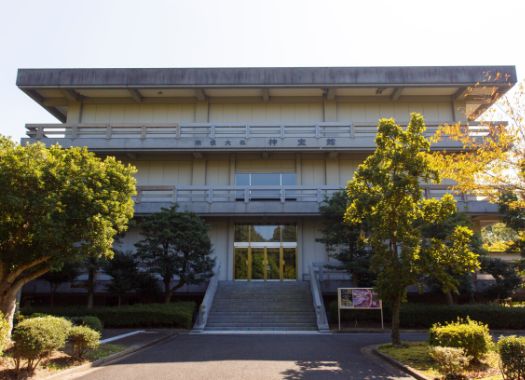
Its collection comprises all 80,000 votive offering artifacts unearthed from ritual sites on Okinoshima, all of which have been designated as National Treasures. They include a triangular-rimmed deity-and-beast mirror, a gold ring, and gilt-bronze dragon heads.
In addition to unearthed artifacts, the museum exhibits premodern texts that demonstrate the prosperity of the Munakata Daiguji family (whose members served as the highest ranking priests of Munakata Taisha) during the medieval period, and offerings donated to the shrine by the Imperial family and the lords of the Fukuoka Domain, and many other sacred treasures of Munakata Taisha.
2331 Tashima, Munakata city, Fukuoka
TEL: 0940-62-1311
FAX: 0940-62-1 315
Hours: 9:00-16:30 (Last entry 16:00)
Every day of the week throughout the year
Admission: Adults 800 yen,
High school and university students 500 yen,
Elementary and junior high school students 400 yen
※200 yen discount for groups (20 or more people) and persons over the age of 65
Uminomichi Munakatakan Museum
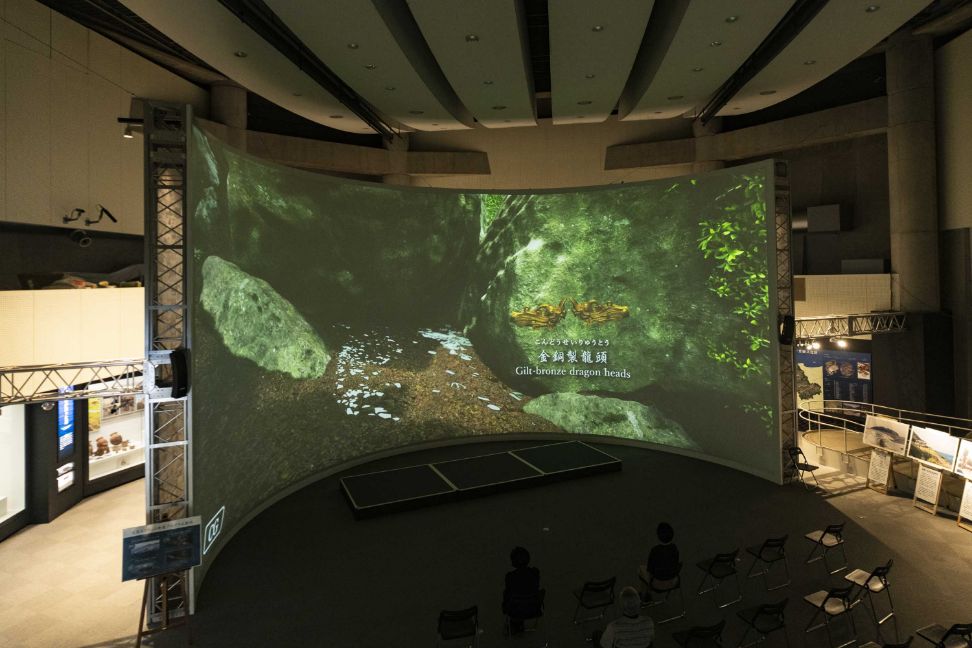
This facility offers an explanatory overview of the entire property. The large screen and 3D movie theater introduces viewers to the experience of being on Okinoshima.
588 Fukata, Munakata city, Fukuoka
Tel: 0940-62-2600
Fax: 0940-62-2601
Hours: 9:00–18:00 daily
Closed Mondays (when Monday is a holiday, closed the following working day) , New Year's holiday
Admission: Free
Chinkoku-ji Temple
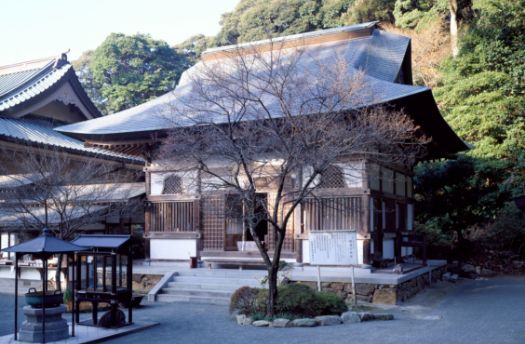
This temple belonging to the Shingon sect of Buddhism was constructed adjacent to Munakata Taisha as a temple attached to the shrine. The temple enshrines five statues of deities, including the three goddesses of Munakata.
Ten-minute walk from Hetsu-miya(770m)
Sakurakyo Mounded Tomb
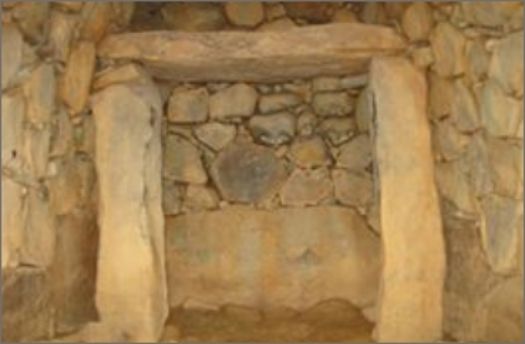
This 40-meter-long keyhole-shaped tomb was constructed in the sixth century. The rear mound has a stone chamber consisting of a stone shelf and stone pillars that support the shelf. The pillars and the wall of the chamber have triangular motifs painted in red, green, and white. (The chamber is not open to the public.))
Ten-minute walk from Konominato Iriguchi bus stop
Twenty-five-minute walk from Hetsu-miya
Tomb of Munakata Ujisada (in Jofuku-ji Temple)
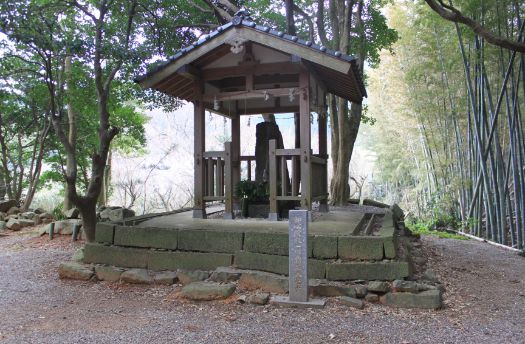
In the sixteenth century, Munakata Ujisada served as the last daiguji (high priest) of Munakata Taisha. Among his achievements, one of the most notable is the reconstruction of the primary shrine (the main hall) of Hetsu-miya.
Take a Nishitetsu Bus from Togoekimae to Kanezakishako (approx. 30min.)
Fifteen-minute walk from Motoura bus stop
Orihata Shrine
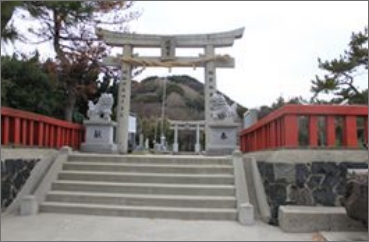
Orihata Shrine is among the shrines listed in the Engishiki (compiled in the tenth century), and was revered by the imperial court in ancient times. During the medieval period the shrine performed rituals associated with Munakata Shrine, and was one of its important subordinate shrines.
西鉄バス「東郷駅前」から「鐘崎車庫」まで乗車(約30分)
Ten-minute walk from Kanezaki Shako bus stop
Links and Contact Information
| Munakata Taisha Shrine Office |
|
|---|---|
| Munakata City Office for World Heritage |
|


